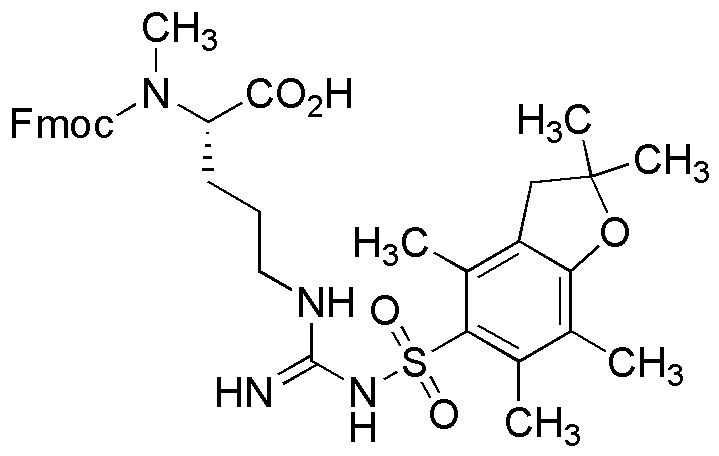Na-Fmoc-Na-methyl-Nw-(2,2,4,6,7-pentamethyldihydrobenzofuran-5-sulfonyl)-L-arginine is widely utilized in research focused on:
- Peptide Synthesis: This compound serves as a protecting group in the synthesis of peptides, allowing for selective reactions without interfering with other functional groups. Its stability under various conditions makes it a preferred choice for chemists.
- Drug Development: In pharmaceutical research, it is used to create peptide-based drugs, particularly those targeting specific receptors. Its unique structure enhances the bioavailability and efficacy of therapeutic agents.
- Bioconjugation: The compound is effective in bioconjugation processes, enabling the attachment of biomolecules to surfaces or other molecules. This is crucial in developing biosensors and targeted drug delivery systems.
- Research in Cancer Therapy: Its application in cancer research is notable, as it can be used to design peptides that selectively target cancer cells, potentially leading to more effective treatments with fewer side effects.
- Protein Engineering: The compound aids in the modification of proteins to enhance their stability and functionality. This is particularly beneficial in biotechnology applications where engineered proteins are used in diagnostics and therapeutics.
General Information
Properties
Safety and Regulations
Applications
Na-Fmoc-Na-methyl-Nw-(2,2,4,6,7-pentamethyldihydrobenzofuran-5-sulfonyl)-L-arginine is widely utilized in research focused on:
- Peptide Synthesis: This compound serves as a protecting group in the synthesis of peptides, allowing for selective reactions without interfering with other functional groups. Its stability under various conditions makes it a preferred choice for chemists.
- Drug Development: In pharmaceutical research, it is used to create peptide-based drugs, particularly those targeting specific receptors. Its unique structure enhances the bioavailability and efficacy of therapeutic agents.
- Bioconjugation: The compound is effective in bioconjugation processes, enabling the attachment of biomolecules to surfaces or other molecules. This is crucial in developing biosensors and targeted drug delivery systems.
- Research in Cancer Therapy: Its application in cancer research is notable, as it can be used to design peptides that selectively target cancer cells, potentially leading to more effective treatments with fewer side effects.
- Protein Engineering: The compound aids in the modification of proteins to enhance their stability and functionality. This is particularly beneficial in biotechnology applications where engineered proteins are used in diagnostics and therapeutics.
Documents
Safety Data Sheets (SDS)
The SDS provides comprehensive safety information on handling, storage, and disposal of the product.
Product Specification (PS)
The PS provides a comprehensive breakdown of the product’s properties, including chemical composition, physical state, purity, and storage requirements. It also details acceptable quality ranges and the product's intended applications.
Certificates of Analysis (COA)
Search for Certificates of Analysis (COA) by entering the products Lot Number. Lot and Batch Numbers can be found on a product’s label following the words ‘Lot’ or ‘Batch’.
*Catalog Number
*Lot Number
Certificates Of Origin (COO)
This COO confirms the country where the product was manufactured, and also details the materials and components used in it and whether it is derived from natural, synthetic, or other specific sources. This certificate may be required for customs, trade, and regulatory compliance.
*Catalog Number
*Lot Number
Safety Data Sheets (SDS)
The SDS provides comprehensive safety information on handling, storage, and disposal of the product.
DownloadProduct Specification (PS)
The PS provides a comprehensive breakdown of the product’s properties, including chemical composition, physical state, purity, and storage requirements. It also details acceptable quality ranges and the product's intended applications.
DownloadCertificates of Analysis (COA)
Search for Certificates of Analysis (COA) by entering the products Lot Number. Lot and Batch Numbers can be found on a product’s label following the words ‘Lot’ or ‘Batch’.
*Catalog Number
*Lot Number
Certificates Of Origin (COO)
This COO confirms the country where the product was manufactured, and also details the materials and components used in it and whether it is derived from natural, synthetic, or other specific sources. This certificate may be required for customs, trade, and regulatory compliance.


